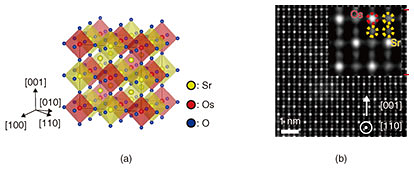 |
|||
|
|
|||
|
Short Reports Vol. 17, No. 7, pp. 47–48, July 2019. https://doi.org/10.53829/ntr201907sr4 Development of Novel Material Sr3OsO6 with the Highest Ferromagnetic Transition Temperature for Insulators—Breaking the World Record for the First Time in 88 years1. SummaryResearchers at NTT Basic Research Laboratories (NTT-BRL) have synthesized Sr3OsO6 (Sr: strontium, Os: osmium, O: oxygen), a novel material that exhibits ferromagnetism above 780ºC, which is the highest temperature among insulators. In collaboration with the Tsuneyuki Research Group at the University of Tokyo, we have also revealed the electronic state of this material, which is the key to comprehending the origin of the emergent ferromagnetism. This discovery surpasses the long-standing Curie temperature (Tc) record for insulators for the first time in 88 years and is thus epoch-making for the development of magnetic materials. It also provides fundamental knowledge about the mechanism of the emergent ferromagnetism at high temperatures. Unlike most conventional magnetic materials, our new material is free from Fe (iron) and Co (cobalt) and hence paves a new way to the exploration and development of other novel magnetic materials. Furthermore, the Sr3OsO6 was synthesized in the form of single-crystalline thin films. This suggests that the Sr3OsO6 films can be readily implemented in device fabrication and are thus promising for high-performance magnetic devices that can be stably operated at high temperatures (room temperature to 250ºC). Examples of such devices include magnetic random access memory (MRAM) and magnetic sensors. This research was reported in Nature Communications on February 12, 2019 [1]. 2. BackgroundFerromagnetic insulators include maghemite, the first magnet that humans discovered and used as a compass. Today, ferromagnetic insulators are widely used as permanent magnets and in microwave devices incorporated into, for instance, smartphones, cars, and computers, and such technology could not have been developed without ferromagnetic insulators. Recently, spintronic devices, in which both the electrical and magnetic properties of electrons are utilized simultaneously, are being extensively investigated to achieve high-speed devices with low power consumption. Ferromagnetic insulators are also thought to be essential constituents that will make such spintronic devices viable. In conjunction with trends in computerization, there has been a steadily growing demand for practical devices with higher performance. In terms of temperature, stable operation even above 200ºC is required. However, the record Tc, which is the crucial factor determining the temperature range in which any ferri/ferromagnetic system remains stable, has stood in insulators ever since ferrite magnets were first developed over eight decades ago in the 1930s. Therefore, researchers have sought to develop the next generation of ferromagnetic insulators with high Tc as well as to establish guiding principles to search for such materials. 3. AchievementsResearchers at NTT-BRL have synthesized the novel material Sr3OsO6 (Fig. 1), using a unique oxide thin-film growth technique developed over many years. The Tc value of this material, estimated from the magnetic measurements, is above 780ºC, which surpasses the Tc record for insulators for the first time in 88 years by more than 100ºC.
Density functional theory calculations carried out by the University of Tokyo team revealed that the ferromagnetic insulating state of Sr3OsO6 originates from the large spin-orbit coupling of the 5d element Os. This insight into the mechanism of the emergent high-temperature ferromagnetism will open a new avenue for developing functional materials in which elements having large spin-orbit coupling play a role. Sr3OsO6 was synthesized in the form of single-crystalline thin films, which have high compatibility with device fabrication processes. This is in marked contrast to typical new oxides often synthesized in a powder or sintered polycrystalline form. Thus, Sr3OsO6 is expected to be readily implemented in high-performance magnetic device applications, such as MRAM and magnetic sensors that work above room temperature. 4. Technical features: preparation of high-quality Sr3OsO6 thin filmsWe used the molecular beam epitaxy method to synthesize the Sr3OsO6 thin films, which have a crystal structure called double perovskite (Fig. 1(a)). Precise control of the flux rate of each constituent cation (Os, Sr) is mandatory in order to grow high-quality Sr3OsO6 thin films. Generally, controlling the flux of Os is a challenge because of its high melting point (3033ºC). Nevertheless, we have succeeded in precisely controlling both the Sr and Os flux rates. We accomplished this by monitoring the flux rates with an atomic emission spectrometer and feeding them back to the evaporation source power supplies in real time, which enabled the synthesis of Sr3OsO6 thin films with the Sr and Os atoms arranged in a highly ordered structure (Fig. 1(b)). 5. Future plansIn our quest to better understand the fundamentals of ferromagnetism, we will further investigate the electronic structures of Sr3OsO6 using advanced spectroscopy techniques provided by synchrotron radiation facilities. We are working to fabricate some test devices comprising Sr3OsO6 to examine the tunnel magnetoresistance effect toward the development of high-performance magnetic devices that can be operated at high temperatures. Reference
For inquiries:Public Relations, NTT Science and Core Technology Laboratory Group |
|||

